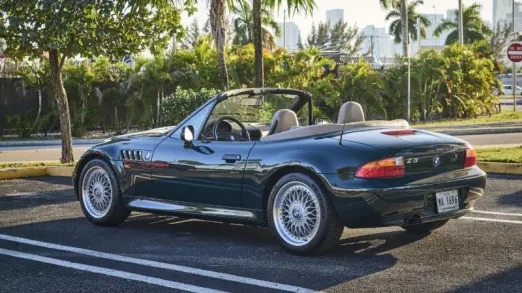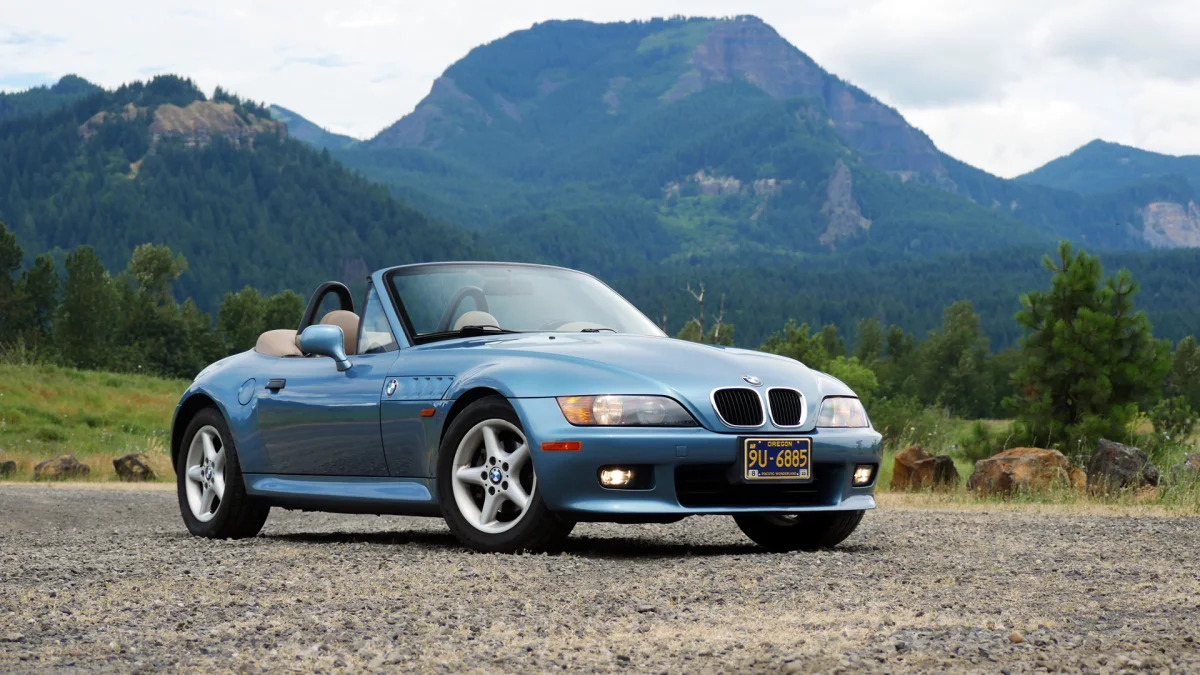When BMW began its quest to create a modern two-seat roadster in the early 1990s, it had one target in mind: the Mazda Miata. The charming and now-classic Miata was a revelation, recapturing some of the two-seater, drop-top magic that took the postwar automotive world by storm. For years, the Miata had a lock on entertaining, moderately priced transportation.
For BMW, it was a challenging reach.
What arrived in 1995, emerging as the first BMW produced at the company's first American car plant in Spartanburg, South Carolina, bore little resemblance to the cute and quirky Japanese roadster. The Z3 was more solid and more upscale. It was also very pretty and immediately attracted gobs of attention worldwide — with a little help from James Bond. It was different from a Miata, but it was still a hit.
The predecessor to the Z3 was the 1989 Z1, although the two are fundamentally different apart from being two-seat convertibles. While the Z1 was a borderline exotic with fanciful drop-down doors, the Z3 was a more cost-conscious creation. As such, it's effectively a parts bin car in a pretty package. Its chassis code is E36/7, indicating its close mechanical relationship with the contemporary BMW 3 Series, the E36. Yet, its rear axle came from the preceding 3 Series, the E30, for reasons related to both cost and packaging (it would later create problems for the high-powered M Roadster). Many of the interior parts were shared with older BMWs as well, such as the pull-out headlight switch and door handles.
Initially, the Z3 was only offered with a 1.9-liter inline-four. Despite the Bond connection, many dismissed it as a "hairdresser's car." That would soon be corrected when BMW dropped in the 2.8-liter inline-six from the 328i, bringing with it a wider, more shapely rear track, a bigger air intake and dual exhaust ports. The 1.9 would eventually be replaced by a 2.5-liter inline-six base engine, while the 2.8 was binned in favor of the then-new 3.0-liter. Of course, those who seek max power lust after the M Roadster, which boasted engines from two generations of M3 (first the 240-hp one from the E36 M3, and then a downgraded, 315-hp one from the E46).
The Z3 was never the razor-sharp handler some may have hoped for, especially given comparisons to the Miata (and eventually the Porsche Boxster). If you want a more engaging driver's car, both remain a better bet. But the Z3 is still pretty, and with the right powertrain (meaning, don't get the 1.9 or a four-speed automatic), it remains plenty of fun to drive to this day.
The Z3 would eventually give way to the far more modern Z4, which nevertheless failed to recapture the Z3's popularity.
Why is the BMW Z3 a Future Classic?
It's all about the looks. As Autoblog contributor Steven Ewing wrote in his Z3 retro review, “for a lot of people, the Z3 was love at first sight. There was strong initial demand, with some 15,000 orders placed by the time it actually went on sale.” The Bond connection was part of that too, while also being a reason it's remained in the automotive zeitgeist for those of a certain age (never mind that its role in "GoldenEye" was rather underwhelming).
A pretty design can only take you so far. The DNA shared with other, iconic BMWs of its era also plays a big role in its continued desirability. The Z3 may not have offered the razor-sharp responses of a Boxster, but it was certainly more dynamically gifted than a Mercedes SLK or Audi TT. Used car prices reflect this hierarchy.
Consider the layout as well: classic front-engine, rear-wheel drive, and apart from the 1.9-liter, big power from sweet-revving engines typically found in bigger coupes and sedans.
And it’s a roadster, which defines a conveyance that offers, as one reviewer for Car & Classic wrote, “the sense of speed, the noise of the engine, the feeling of being at one with your surroundings rather than simply observing them through a sheet of glass.” A super-low beltline also meant that your peripheral vision was filled with pavement whizzing by.
Of course, like all potential future classics, certain versions are going to be more desirable and valuable as a result. An inline-six and manual transmission are the most obvious. Then you're looking at more interesting color choices. Finally, there are the super-special versions: the M Roadster, with the later 315-horsepower version being the absolute pinnacle of the Z3 breed, as well as the rare Z3 Coupe and M Coupe — both deserving of a "Future Classic" treatment of their own.
What is the ideal example of a BMW Z3?
As we just mentioned, it's all about the M Roadster. While the original, four-cylinder Z3 was an answer to the Miata, the M Roadster was more like a Shelby Cobra: big power in a small, two-door package.
Every M Roadster had a 3.2-liter inline-six from an M3, but there were in fact two different 3.2-liter inline-sixes offered throughout the M Roadster's run from two different generations of M3. The original M Roadster engine, which had a longer run and sold in greater numbers, produced 240 hp. That was a sizable bump over the 189-hp 2.8-liter, resulting in a 0-60 time of 5.2 seconds versus 6.3. Note that both were very quick for their day. The performance gap shrunk considerably for 1999 when the 228-hp 3.0-liter was introduced, although the M Roadster still had its upgraded suspension, lower ride height, better brakes and fatter tires (much of which was shared with the M3). It was arguably the best-looking Z3, too, with its sleek lower air dam, unique side gills, quad pipes and unique rear end that relocated the license plate to the trunk lid.
For 2001 and 2002, however, the M Roadster left no doubt as to which Z3 variant was king of the hill. It received the same 3.2-liter "S54" inline-six from the then-new E46 M3. Power shot up to 315 hp, which was admittedly less than the M3's 333 hp due to a more restrictive exhaust and North American emissions requirements. Oh well. Having that much power in something as small and relatively crude as a Z3 body was a recipe for tire-smoking hilarity. It could also cause some problems for the rear subframe that was never meant for anywhere close to that much power (you can read about the issue in-depth here).
The M Roadster was also offered in unique paint and leather colors, which do enhance their visibility and value.


The Z3 received a styling update for 2000, with the rear end getting a bit more shapely. You can see the before and after above.
Are there any good alternatives to the BMW Z3?
As noted above, the Miata, which harkened back to the days of popular British roadsters — think Triumph, MG, Austin Healey — is an obvious choice for open-air driving. But the Z3 oozed class and a European heritage. A used model could easily match up today against a couple of (more expensive) German entries, the Porsche Boxster and the Audi TT.
From Japan, a natural match to the BMW might be the Honda S2000 roadster from 1999. The high-winding, naturally aspirated, 9,000-RPM, 240 horsepower inline four was the highest naturally aspirated horsepower-per-displacement engine for a decade; it was located entirely behind the front axle to allow for a 50/50 weight distribution.
In domestic terms, of course, we’ve got the muscle cars: Ford Mustang, Chevy Camaro, et al. But a roadster purist might give you an argument there. There’s also the Z3 M Coupe out there, but that’s another story.
Values fluctuate wildly for the Z3. BMW sold quite a lot of them, meaning they weren't hard to get, and therefore any that served as daily drivers have ended up just as worse-for-wear as any other 25-30-year-old car. Those can be had for a few thousand bucks, but you don't want them. You're really looking for a low-mileage garage queen, and depending on engine, transmission and color combination, you could be looking at anywhere between $9,000 and $20,000, with most existing on the lower end of that. M Roadsters would be on the upper end of that range, with the exception of the later S54-engined versions that are not only more desirable, but rarer. Those prices are in the $30s or beyond.












Sign in to post
Please sign in to leave a comment.
Continue